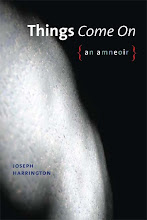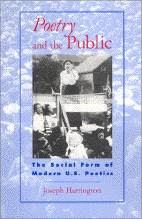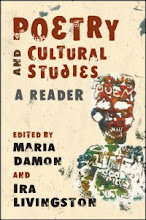I still don't quite get what Susan Howe was doing in The Midnight. I mean, it hits on a lot of her major themes - legibility, lostness and discovery, textual mediation, margins v. center, etc. And there are the small, double-spaced poems in the middle of the page. But this book seems very different.
In many (most?) of Howe's books, we get a short prose introduction/explanation/narrative detailing what motivates the poems - and where some of the lines come from. This is a very useful and clever method, insofar as it preremps the "What's it about?" question. The prose bit gives you some notion of what the poems are alluding to, what the tone is to be, and what's prompting the feeling (and leaps of thought). In The Midnight by contrast, we get a series of poems, then a section of prose snippets, poems, prose, poems. The final set of poems, "Kidnapped," clearly pick up on themes and even texts that the prose parts introduce. But the relation between the other poems, "Bedhangings," which were originally collected as a chapbook of that name, and the prose sections that divide them, is rather cryptic.
Moreover, the relation of the prose pieces (each titled) to one another is often a bit mystifying. How does the early life of Frederic Law Olmstead relate to the origin of starching in fabrics relate to Howe's aunt and uncle? These sections are rendered in prose that is more-or-less linear and representational: it's clear how one person relates to another, or one object relates to those persons, and usually how one sentence relates to the next - which maybe leads me to expect more connections between the titled sections. One of the themes of the book is relationality - what's created when one thing is set next to another. That's OK until the relationality looks like that between the strands of spaghetti stuck to the wall. I mean, if I sent this to a publisher - even your friendly neighborhood avant publisher - they'd tell me to get lost. Granted, the writing wouldn't be as good, or the family stories as interesting. But even if they were, the form of the text offers so little purchase for the reader, that the reader has to be motivated already. You keep reading b/c it's by Susan Howe.
So, I read Marjorie Perloff's article, which gave excellent close readings of individual sections, but not much sense of why all of these disparate elements are in the same book. Then I read John Palattella's review, which told me that "Howe catalogues details in an almost forensic way" and does so by "cracking the looking glass and making the incongruous appear even more so." Moreover, "The prose sections . . . . present a collage of brief narratives, with coincidence and synchronicity being the only means offered for aligning and organizing them." Reading these lines made me feel like I wasn't losing my mind after all. But in other books by Howe I always had a sense of how each section w/in a book hung together (loosely, anyway), and I saw the thematic filaments that led me from one to another and back.
Then I read Stephen Collis' review, and that helped. The "Bedhangings" poems relate text and textile, and the obssession w/the interleaves of books deals with another kind of "curtain," which in turn "is also the false front we present to the world," which Howe's actress-mother certainly did (when the curtain went up). "The curtain protects . . . but it also excludes." All of which rhymes with the account of trying to get into the Houghton Library at Harvard, and then trying to "get at" the books behind the "locked glass." Or how "while one voice excludes ('Go away') another includes."
That's really the issue: why these fragments? Why not that one - the one that was left out?
In any case, I had been suspecting what Collis says in as many words: that The Midnight is not so much about Howe's mother (as Palattella holds) as about Howe herself - or at least her work. It's almost like reading a "greatest hits," at least in terms of her intellectual concerns, tropes, forms: "she notes how 'you must turn Uncle John's books around and upside down to read the clippings and other insertions pasted and carerfully folded inside.' Again one is struck by the similarity between this and Howe's own books, where upside-down and off-kilter lines cause one to constantly turn her books about inthe midst of reading."
So, yes, noone but Howe could have published a book like this, but noone but Howe would have written it. And perhaps noone but Howe fans would be interested in reading it. If this were the first book of hers you read, it would be a disaster. But if you read it in the context of the rest of her oeuvre, you can see how one part of the book might "rhyme" with another. The family history/memoir is in a sense just another path into the woods - albeit a particularly treacherous and overgrown one.
All of which makes me wonder if one should read each of Howe's books as a chapter of a larger, yet-to-be-collected work.
All of which is, of course, my own anxieties about my writing projected onto Howe's book.
Me in my Obama shirt, Lilith on her new leash
-
Lilith was quite literally dogging it up Kahekili (although I gather I'm
using "literally" figuratively) when Don came jogging behind us. Lilith
stoppe...
13 hours ago











No comments:
Post a Comment